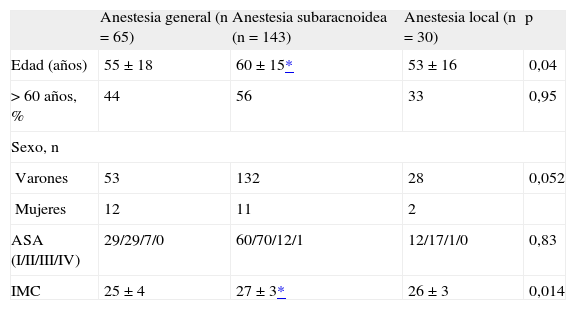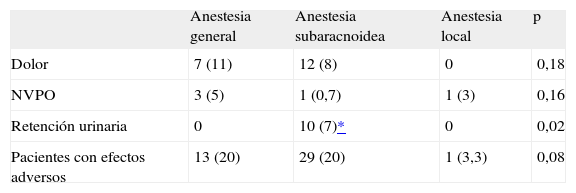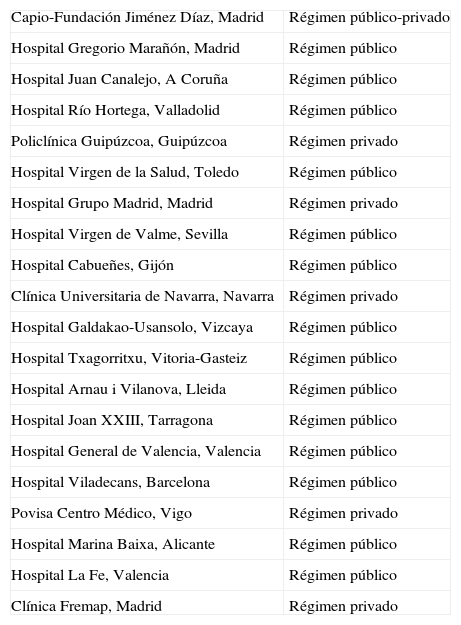Recientemente se ha producido renovado interés sobre la técnica anestésica en la cirugía de la hernia inguinal y las ventajas y los inconvenientes derivados de las diferentes técnicas anestésicas. En nuestro país no hay información acerca de la la técnica anestésica en la hernioplastia. Nuestro objetivo es realizar un estudio epidemiológico sobre las técnicas anestésicas en la cirugía de la hernia inguinal.
Pacientes y métodosEstudio epidemiológico transversal, descriptivo y multicéntrico en 20 hospitales de España. Cada centro incluyó a 12 pacientes sometidos a herniorrafia y registró datos sociodemográficos, antecedentes patológicos, técnica realizada, parámetros de recuperación y complicaciones.
ResultadosSe incluyó a 238 pacientes (el 91% ASA I-II), con una media de edad de 57 (25-84) años, 213 varones y 25 mujeres. El régimen de hospitalización fue: cirugía ambulatoria un 47%, corta estancia un 26% y el resto con ingreso. Se realizó anestesia subaracnoidea en un 60%, anestesia general en un 27% y anestesia local con sedación, habitualmente benzodiacepinas, en un 13% de los casos. El alta de los pacientes intervenidos en régimen de cirugía ambulatoria fue entre 1 y 6h en el 94 y el 100% de los casos de anestesia general y anestesia local respectivamente, frente a un 68% para la anestesia subaracnoidea. No hubo diferencias en las características del dolor, náuseas y vómitos entre las técnicas anestésicas; sin embargo, hubo 10 episodios de retención urinaria, todos ellos en el grupo de anestesia subaracnoidea, en pacientes varones y con una edad media de 68 años.
ConclusionesLa anestesia subaracnoidea es la más utilizada en España para la herniorrafia, y se asocia con una elevada incidencia de retención urinaria y retraso en el alta hospitalaria (> 6h en un 32% de los casos) en comparación con la anestesia local. Esta debería ser promovida activamente en nuestro país.
Despite renewed interest in the management of anaesthesia during inguinal hernia surgery, there is a lack of data on trends in anaesthesia in Spain. The purpose of this study was to analyse the different anaesthetic techniques used in inguinal hernia surgery and their association with recovery, hospital stay, complications, and satisfaction with the technique.
Patients and methodsOurs was a multicentre, descriptive, cross-sectional epidemiological study performed at 20 Spanish hospitals. Each centre included 12 patients who underwent elective inguinal hernia repair. Data were collected on patient characteristics, clinical history, anaesthetic technique, post-operative recovery, and complications.
ResultsData were collected on 238 patients, most of whom (91%) were ASA I or II, with a mean age of 57 years (25-84). Day surgery was performed in 47% of cases; 26% as one-day surgery, and the rest as inpatient surgery. Spinal anaesthesia was the most widely used technique (60%), followed by general anaesthesia (27%), and local anaesthesia with sedation (13%) (pP<.0001). Discharge was within 6hours with general anaesthesia and local anaesthesia in 94% and 100% of cases, respectively, compared with 68% for spinal anaesthesia (001). No differences were observed between anaesthetic techniques in terms of adverse effects, except for urinary retention in 10 male patients (mean age 68 years) all of whom had received spinal anaesthesia.
ConclusionsSpinal anaesthesia is the most commonly used technique in Spain for inguinal hernia repair, although it is associated with a longer hospital stay (greater than 6h in 32% of cases) and a high incidence of urinary retention than other anaesthetic methods, in particular those with local infiltration. These techniques should be more vigorously implemented in daily practice
Artículo
Comprando el artículo el PDF del mismo podrá ser descargado
Precio 19,34 €
Comprar ahora












